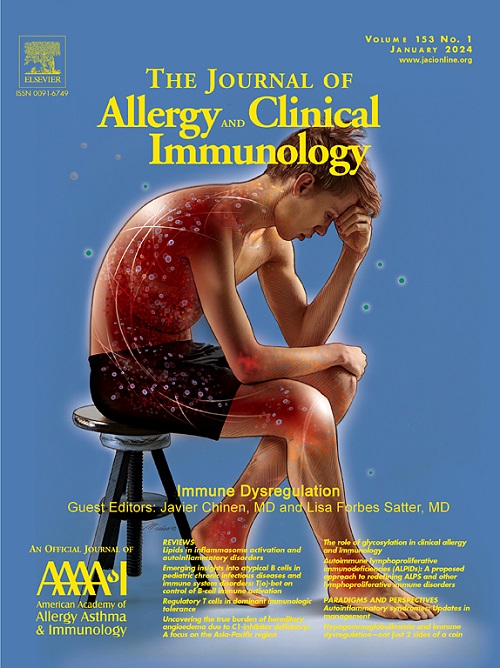Targeting alarmins in asthma: From bench to clinic
IF 11.4
1区 医学
Q1 ALLERGY
引用次数: 0
Abstract
Over the past 2 decades, mechanistic studies of allergic and type 2 (T2)-mediated airway inflammation have led to multiple approved therapies for the treatment of moderate-to-severe asthma. The approval and availability of these monoclonal antibodies targeting IgE, a T2 cytokine (IL-5) and/or cytokine receptors (IL-5Rα, IL-4Rα) has been central to the progresses made in the management of moderate-to-severe asthma over this period. However, there are persistent gaps in clinician’s ability to provide precise care, given that many patients with T2-high asthma do not respond to IgE- or T2 cytokine–targeting therapies and that patients with T2-low asthma have few therapeutic options. The new frontier of precision medicine in asthma, as well as in other allergic diseases, includes the targeting of epithelium-derived cytokines known as alarmins, including thymic stromal lymphopoietin, IL-25, IL-33, and their receptors. The effects of these alarmins, which can act upstream of immune cells, involve both the innate and adaptive systems and hold potential for the treatment of both T2-high and -low disease. Tezepelumab, an anti–thymic stromal lymphopoietin antibody, has already been approved for the treatment of severe asthma. In this review, we discuss our current understanding of alarmin biology with a primary focus on allergic airway diseases. We link the mechanistic corollaries to the clinical implications and advances in drug development targeting alarmins, with a particular focus on currently approved treatments, those under study, and future potential targets in alarmin signaling pathways.
针对哮喘的警报-从长凳到诊所。
在过去的二十年中,对过敏性和2型(T2)介导的气道炎症的机制研究已经导致多种治疗中重度哮喘的疗法获得批准。这些针对免疫球蛋白E、2型细胞因子(IL-5)和/或细胞因子受体(IL-5Rα、IL-4Rα)的单克隆抗体的批准和可用性,在这一时期在中重度哮喘治疗中取得了进展。然而,考虑到许多2型高哮喘患者对IgE或T2细胞因子靶向治疗没有反应,以及2型低哮喘患者的治疗选择有限,临床医生提供精确护理的能力一直存在差距。精准医学在哮喘以及其他过敏性疾病中的新前沿包括靶向上皮源性细胞因子、“警报器”,包括TSLP、IL-25、IL-33及其受体。这些警报的作用可以作用于免疫细胞的上游,涉及先天和适应系统,并具有治疗2型高和低疾病的潜力。Tezepelumab是一种抗tslp抗体,已被批准用于治疗严重哮喘。在这篇综述中,我们讨论了我们目前对警报蛋白生物学的理解,主要集中在过敏性气道疾病上。我们将机制推论与针对警报的药物开发的临床意义和进展联系起来,重点关注当前批准的治疗方法,正在研究的治疗方法,以及警报信号通路中未来的潜在靶点。
本文章由计算机程序翻译,如有差异,请以英文原文为准。
求助全文
约1分钟内获得全文
求助全文
来源期刊
CiteScore
25.90
自引率
7.70%
发文量
1302
审稿时长
38 days
期刊介绍:
The Journal of Allergy and Clinical Immunology is a prestigious publication that features groundbreaking research in the fields of Allergy, Asthma, and Immunology. This influential journal publishes high-impact research papers that explore various topics, including asthma, food allergy, allergic rhinitis, atopic dermatitis, primary immune deficiencies, occupational and environmental allergy, and other allergic and immunologic diseases. The articles not only report on clinical trials and mechanistic studies but also provide insights into novel therapies, underlying mechanisms, and important discoveries that contribute to our understanding of these diseases. By sharing this valuable information, the journal aims to enhance the diagnosis and management of patients in the future.

 求助内容:
求助内容: 应助结果提醒方式:
应助结果提醒方式:


